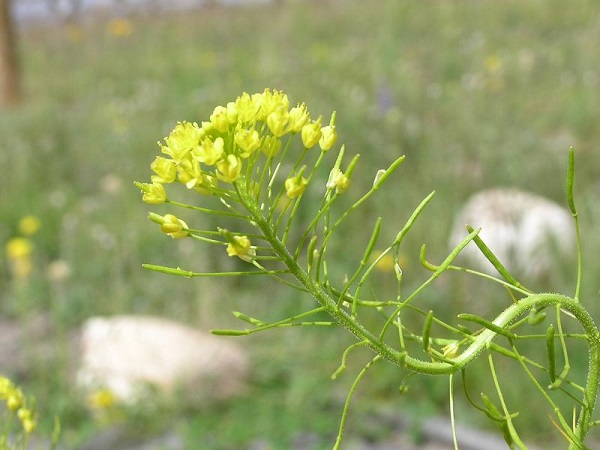 |  |  |   |  |
 |  |
Flixweed is an annual, poisonous plant that grows to a height of 10-80 cm. It has a very unpleasant aroma. The stem is erect, branched, thickly leafy, with gray hairs. The leaves are arranged alternately, divided into double or triple tufts, length 1.5-8cm, width 0.8-3cm.
The flowers of Smalkhodzene are pale yellow in color, arranged in a cymerus inflorescence. The fruits of Flixweed are multi-seeded pods, 10-30mm long. The fruits are slightly curved. The seeds are oval and yellow-brown in color, slightly flattened. The plant blooms from May to August, then the fruits ripen from August to September.
The above-ground part of the plant, the roots and even the young pods are used for medicinal purposes. As a rule, the roots are collected after the seeds of the plant have ripened - in August or September, the seeds - while watching how the pods mature, the leaves and stems are collected while the plant is blooming.
Cut the Flixweed scallions into pieces and lay them on sieves, <3cm thick. It is necessary to stir the drug every day, because it has a tendency to rot. When the drug is dry, it is put in cloth bags. This is a mandatory condition. In addition, do not seal the drug in bags!
The bags should be stored in a well-ventilated and dry place, this will ensure that you can store the drug for 2 years or more.
The seeds of the Flixweed are harvested as they ripen. They are dried with all the pods, then thawed and sieved. The seeds can be stored in a tightly closed glass container for one year.
Flixweed contains steroidal saponins, alkaloids, coumarins, organic acids, mineral salts, thioglycosides, alcohol, cardenolides, pigments, vitamins, vegetable fats and mustard oil. In addition, the chemical composition of the plant has not been fully explored. It is known that the seeds of Flixweed contain vegetable fat (27-30%), the poisonous glycoside sinigrin (<0.9%), allyl disulfide (12.5%), benzyl isothiocyanate (60%), allyl isothiocyanate (15%), etc.
Vegetable fats and mustard oil contain linoleic acid, arachidic acid, erucic acid and other fatty acids, as well as organic acids. Carotene (10%) and vitamins C, E, P are also found in the leaves of smalkahodzene.
Medicinal significance
Despite the fact that Flixweed is not used in official medicine, due to its valuable chemical composition, it has several valuable properties. It is diuretic, astringent and bactericidal. Its hemostatic and anti-helminthic activity is also known.
Since ancient times, this plant has been known in the medicine of various nations.
A decoction of Flixweed is used for diarrhea, dysentery, edema, gallstones and kidney diseases.
Decoctions of Flixweed are a good anti-hemorrhagic agent for expectoration of blood and uterine bleeding, it also helps during hysterical attacks and as an anthelmintic. It is worth mentioning that the plant is also used in case of diabetes.
In folk medicine, decoctions and infusions of Flixweed are used to treat malaria, colds, and fever. It is believed that the plant prevents the development of tumors by acting as a brake.
A concentrated solution is prepared for washing wounds and skin ulcers. For faster healing of festering wounds and cuts, apply fresh, crushed leaves of Flixweed locally.
This plant is also widely used in Ayurveda. A decoction of the seeds is widely used as a bitter agent for expectoration. In addition, the healing properties of Flixweed are used in cases of bronchitis, fever, gallstones, as well as nervous tension. Decoctions of the plant are also useful as a remedy for scurvy.
